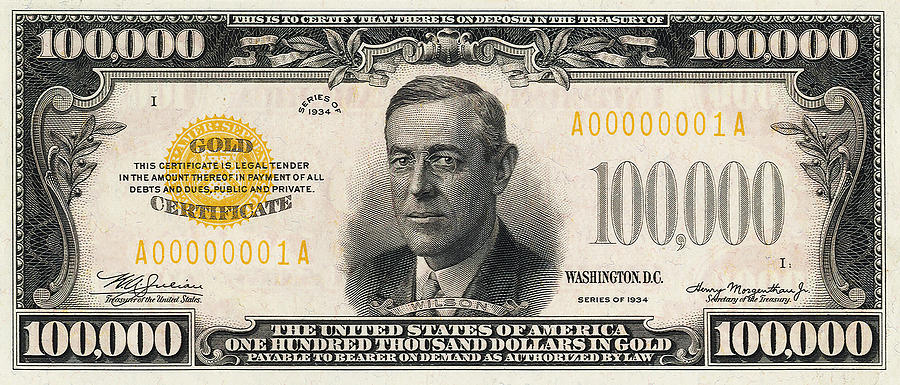
U.S. One Hundred Thousand Dollar Bill - 1934 $100000 USD Treasury Note

by Serge Averbukh
Buy the Original Digital Art
Price
$1,500
Dimensions
96.000 x 41.125 inches
This original digital art is currently for sale. At the present time, originals are not offered for sale through the Serge Averbukh - Website secure checkout system. Please contact the artist directly to inquire about purchasing this original.
Click here to contact the artist.
Title
U.S. One Hundred Thousand Dollar Bill - 1934 $100000 USD Treasury Note
Artist
Serge Averbukh
Medium
Digital Art - Digital Painting
Description
Introducing 'Paper Currency' collection by Serge Averbukh, showcasing new media paintings of world paper currency of past and present, restored, enhanced and transformed into large format fine art prints. Here you will find pieces featuring a U.S. One Hundred Thousand Dollar Bill - 1934 $100000 USD Treasury Note (Proof; based on hi res image provided by National Numismatic Collection, National Museum of American History).
Large denominations of US currency greater than $100 were circulated by the US Treasury until 1969. Since then, the U.S. dollar has only been issued in seven denominations: $1, $2, $5, $10, $20, $50, and $100. As of 2017, four of the five larger denominations: the $500, $1,000, $5,000, and $10,000 bills, printed for general use (in large transactions), remain usable as legal tender while $100,000 bills were never circulated, being only for certain internal transactions. Large-denomination currency (i.e., banknotes with a negotiable face value of $500 or higher) had been used in the United States since the late 18th century. The first $500 note was issued by the Province of North Carolina, authorized by legislation dated May 10, 1780. Virginia quickly followed suit and authorized the printing of $500 and $1,000 notes on October 16, 1780 and $2,000 notes on May 7, 1781. High-denomination treasury notes were issued, for example during the War of 1812 ($1,000 notes authorized by an act dated June 30, 1812). During the American Civil War Confederate currency included $500 and $1,000 notes. During the Federal banknote issuing period (1861 to present), the earliest high-denomination notes included three-year Interest-bearing notes of $500, $1,000, and $5,000, authorized by Congress on July 17, 1861. In total, 11 different types of U.S. currency were issued in high-denomination notes across nearly 20 different series dates. The obverse of United States banknotes generally depict either historical figures, allegorical figures symbolizing significant concepts (e.g., liberty, justice), or a combination of both. The reverse designs range from abstract scroll-work with ornate denomination identifiers to reproductions of historical art works.
Although they are still technically legal tender in the United States, high-denomination bills were last printed on December 27, 1945, and officially discontinued on July 14, 1969, by the Federal Reserve System,[9] supposedly due to 'lack of use'. The $5,000 and $10,000 effectively disappeared well before then.[nb 1]
The Federal Reserve began taking high-denomination currency out of circulation (destroying large bills received by banks) in 1969. As of May 30, 2009, only 336 $10,000 bills were known to exist; 342 remaining $5,000 bills; and 165,372 remaining $1,000 bills. Due to their rarity, collectors often pay considerably more than the face value of the bills to acquire them. Some are in museums in other parts of the world.
For the most part, these bills were used by banks and the Federal government for large financial transactions. This was especially true for gold certificates from 1865 to 1934. However, for the most part, the introduction of an electronic money system has made large-scale cash transactions obsolete. When combined with concerns about counterfeiting and the use of cash in unlawful activities such as the illegal drug trade and money laundering, it is unlikely that the U.S. government will re-issue large denomination currency in the near future, despite the amount of inflation that has occurred since 1969 (a $500 bill is now worth less, in real terms, than a $100 bill was worth in 1969). According to the U.S. Department of Treasury website, "The present denominations of our currency in production are $1, $2, $5, $10, $20, $50 and $100. The purpose of the United States currency system is to serve the needs of the public and these denominations meet that goal. Neither the Department of the Treasury nor the Federal Reserve System has any plans to change the denominations in use today.
Uploaded
April 11th, 2017
Statistics
Viewed 40,208 Times - Last Visitor from Norwalk, CT on 04/23/2024 at 5:10 AM
Embed
Share
Sales Sheet
Comments
There are no comments for U.S. One Hundred Thousand Dollar Bill - 1934 $100000 USD Treasury Note . Click here to post the first comment.
























































